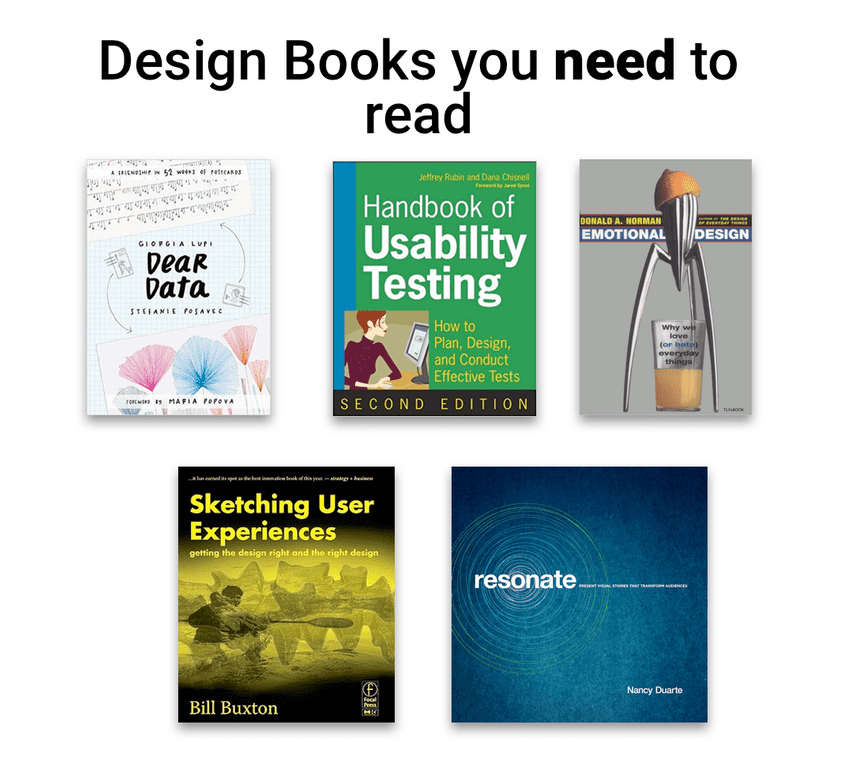Dear Data
A beautiful book written or rather sketched by two information designers Georgia and Stefanie about data visualization. The book is in the form of these postcards that the authors send out to each other with a visualization of a data they decided to track that week. Each week they jointly select one aspect of daily life and depict in the form these hand-drawn visualizations.
The beauty of the book is in the details. How it captures the non-linear nature of the human experience. How it’s always contradictory. Throughout the book, you will see this almost poetic display of visual metaphors. Each of the designers has this distinct style and they showcase it in their visualizations. Its a must-have.
Resonate
This is a book on visual storytelling and let me tell you one thing about it. Its so good. Nancy Duarte writes about the art of influencing an audience with storytelling. The book tells you about the fundamentals of laying out ideas to create a narrative. Something that I remember is how you should also plan for the journey your audience takes along with you. For effective storytelling, you have to take them from one manner of doing to a new manner of doing something
You also need to acknowledge the sacrifice an audience has to make to adapt your narrative. Its a natural tendency of humans to resist your design and find errors in it. You should contemplate all the ways in your audience might resist and make sure you yourself address those concerns as a first step.
Sketching User Experience
This is a must-have book for all User Experience Designers. The book is primarily about techniques and process that uses sketching to put “experience” front and centre in our design process. One of the advantages of sketching is their ambiguous nature. If they don’t specify everything, they tend to encourage diverse interpretations which can help the design process. One of the examples that stood out was effective story-boarding for sketching the interaction and experience of using a product.
He also talks about paper-based flipbook animation for defining direct manipulation based sketches. Lets say, you had to define how a user scales a rectangle in a graphics app that you are designing for. A paper flipbook style animation can help you here
Handbook of Usability Testing
Usability testing is fascinating because it lets you see the design through your user’s eyes. It brings a unique value to the design process that no amount of discussion or debate would ever surface. This book starts out by talking about a great situation that might make you convinced to do more usability testing. Lets say, a user receives a prompt on an application that you designed, that asks them to “Hit enter to default”. Someone could choose to reply something as strange as “I have never defaulted to anything before and I am not going to start now”. How do you accomdate for that in your brainstorming session? A usability test is your best bet to uncover something like that.
The book talks about what usability testing is, when should you test for your product, How to develop a test plan, what are the methods of testings, How do you find participants and much more. For me, the most valuable part was about the skillsets required in the test moderator. The person overseeing the testing should be a people person and should be empathetic to the hurdles users face when they are performing the task.
Emotional Design
Emotional Design by Don Normal is a wonderful take into observing how designers can create usable and also emotionally affecting products. The book details out the 3 different aspects of design — the visceral level which concerns with the appearance of a product. the behavioural level which has to do with the effectiveness of using a product and the reflective level which concerns with the contemplative part of a design. A design artifact tells a story and connects with the user if it affects on any of these emotional levels.
An example of this could be Instant messaging which may attract you on a visceral level by being this new form of communication where you use stickers, gifs, video and audio to deliver your message. On a behavioural level, it’s letting you communicate while you perform other tasks, its hidden from sight and is available when you need it. On the reflective level, it’s letting you stay connected with friends family no matter where you are. That short buzz is letting you know that someone “is there for you” at this moment
I hope these suggestions proved useful to you. Keep learning, suggest some other good books that you know of.
